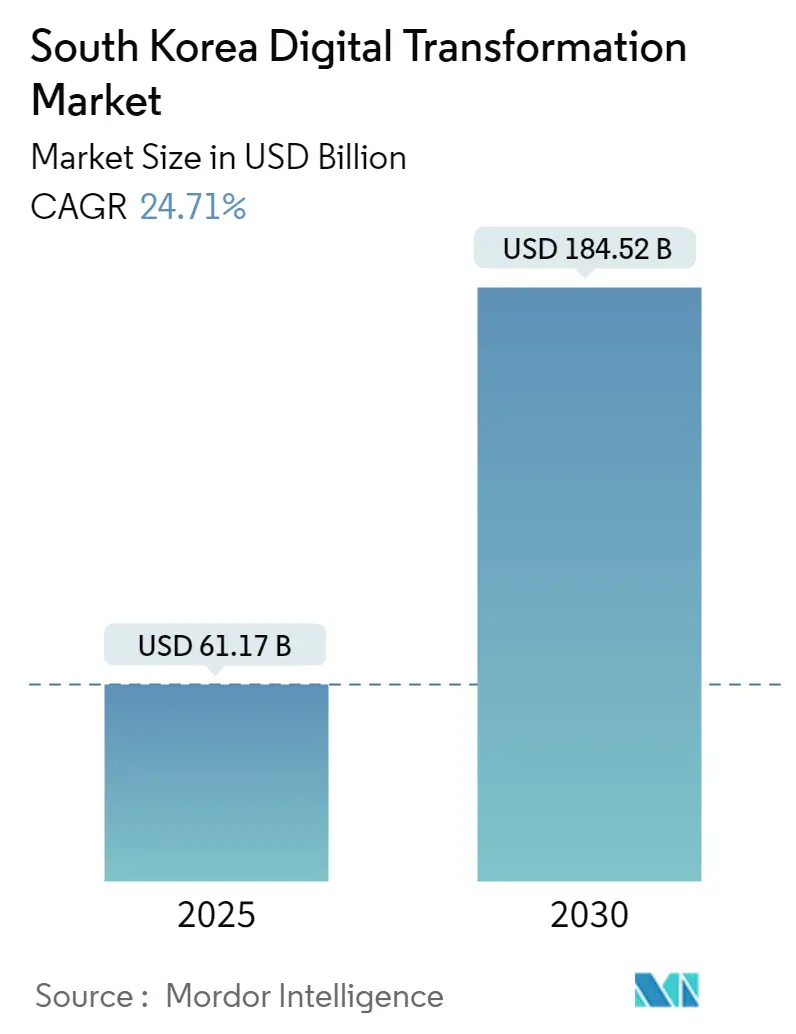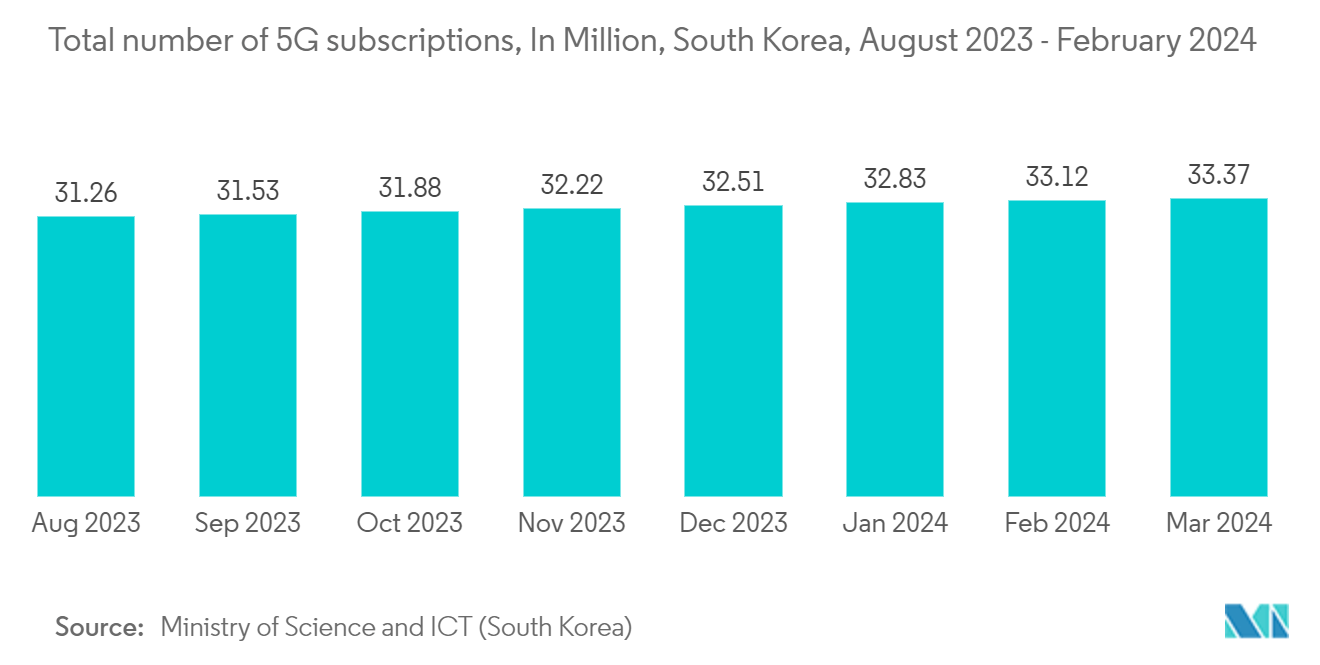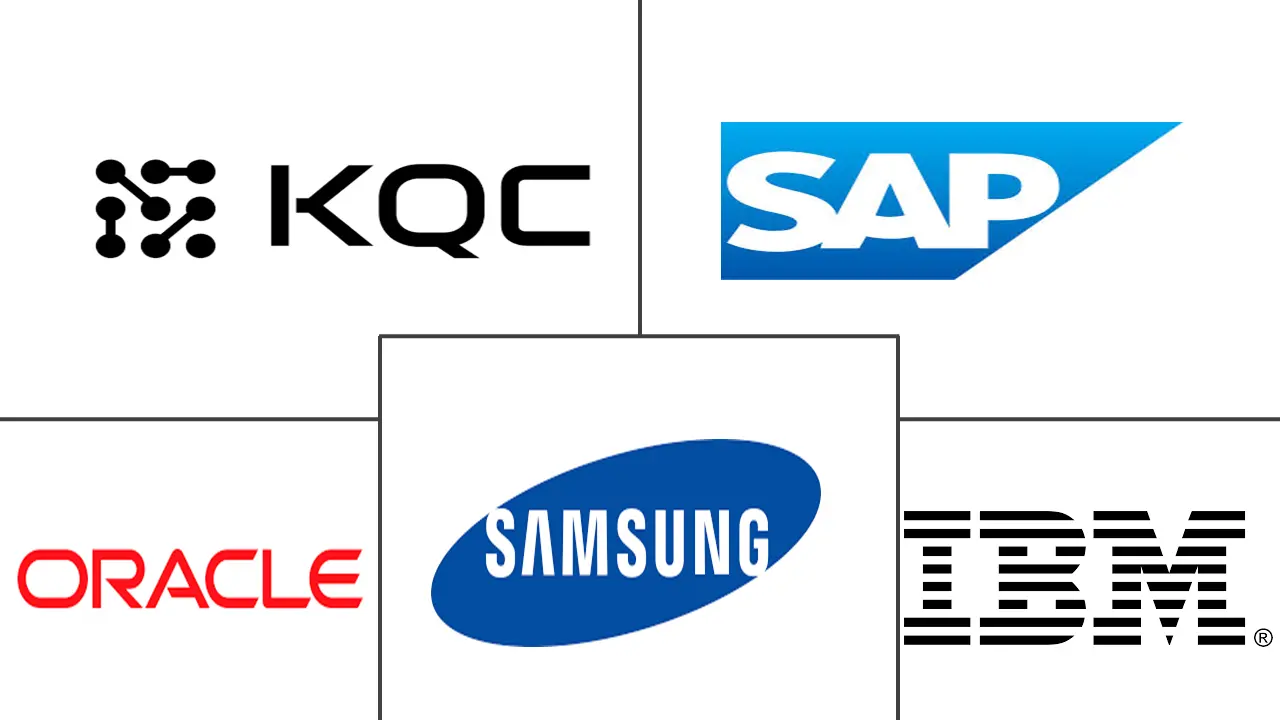South Korea Digital Transformation Market Size and Share

South Korea Digital Transformation Market Analysis by Mordor Intelligence
The South Korea Digital Transformation Market size is estimated at USD 61.17 billion in 2025, and is expected to reach USD 184.52 billion by 2030, at a CAGR of 24.71% during the forecast period (2025-2030).
- AI is being integrated across various sectors, including healthcare, finance, manufacturing, and retail. There are significant opportunities for AI-driven innovations in predictive analytics, personalized customer experiences, and automated processes. For instance, in April 2024, South Korean President Yoon Suk Yeol announced that South Korea planned to invest approximately USD 6.94 billion (9.4 trillion won) in artificial intelligence by 2027. This move is a strategic endeavor to solidify the nation's dominance in semiconductor chips.
- The government is also investing heavily in smart city projects that integrate IoT, big data, and AI to improve urban living. For instance, BUSAN (South Korea's second-largest city) aims to create Eco-Delta City (EDC), positioned as the national flagship for smart city initiatives. EDC is aimed at showcasing the future of urban living. The primary goal is to tackle urban challenges with a focus on investing in sustainable lifestyles for its residents. The city's vision is to elevate the quality of life, especially for its aging population, by bolstering healthcare services and overall well-being. Furthermore, EDC prioritizes real-time disaster management, from floods to fires, as a cornerstone of its citizen safety strategy.
- The adoption of cloud services is accelerating as businesses seek scalable and flexible IT solutions. There’s a growing trend toward hybrid and multi-cloud environments supported by major providers like AWS, Google Cloud, and local players. Government initiatives are also focusing on accelerating digital transformation by investing in data infrastructure, including cloud computing and AI initiatives.
- Stringent data protection and privacy laws prevent the adoption of new technologies, particularly those involving data analytics and cloud computing. Moreover, implementing digital transformation requires significant infrastructure, software, and training costs, which restricts smaller organizations' entry into the market.
- The pandemic accelerated digital transformation growth across various sectors, pushing companies to adopt digital tools and processes to maintain operations. The surge of e-commerce activities shifted consumers toward online shopping, necessitating digital infrastructure, payment systems, and cybersecurity improvements.
South Korea Digital Transformation Market Trends and Insights
Analytics, Artificial Intelligence, and Machine Learning to Witness the Growth
- South Korea's government is investing in AI and ML technologies as a part of a broader digital transformation strategy. Initiatives like the "AI National Strategy" aim to position Korea as a global leader in AI by 2030. Korea is pushing for widespread AI adoption, targeting a 30% uptake among local companies by 2030. Additionally, the nation is striving to nurture a minimum of 100 companies to become global AI solution providers. These objectives underscore Korea's acknowledgment of AI's pivotal role in digitally transforming its businesses and industrial landscape.
- Artificial Intelligence and Machine Learning have various applications across industries, such as manufacturing, healthcare, finance, and transportation. The adoption of AI technologies is expected to drive rapid growth. Additionally, as an OECD member, South Korea plays an active role in the organization's AI Task Force. The nation collaborates in initiatives like the Global Alliance on Artificial Intelligence (GAIA), focusing on ethical and socio-economic AI concerns.
- Moreover, the country recognizes the pivotal role of international collaboration in advancing AI. South Korea has forged strategic alliances with major global AI leaders, including the United States, Japan, and the European Union. These partnerships facilitate the exchange of expertise, foster joint research initiatives, and promote cross-training programs. For instance, In May 2024, the UK and the Republic of Korea unveiled their intentions for the imminent global talks on the safe advancement of Artificial Intelligence (AI) technologies. The agenda included deliberations on AI safety, harnessing the potential of advanced AI models, promoting inclusivity, and paving the way for future innovations.
- There is a growing startup ecosystem promoting analytics, artificial intelligence, and machine learning, with many startups receiving the necessary support and funding for growth. In February 2024, SK Telecom, South Korea's leading telecommunications company, announced a strategic partnership with the U.S.-based AI startup Perplexity. The collaboration aimed to introduce an AI-powered search engine as a direct competitor to Google and Naver and to SK Telecom's user base. Under this partnership, SK Telecom's subscribers planned to gain complimentary access to Perplexity's premium services.
- The rollout of 5G technology in South Korea is also facilitating the deployment of AI and ML by providing the necessary infrastructure for advanced applications and services. As per the Ministry of Science and ICT (South Korea) data, there is growth in 5G connections in the country, which reached 33.37 million by March 2024, from 33.12 million connections in February 2024. This growth will also drive the market for AI and ML in 5G infrastructure.

IT and Telecom Holds the Largest Share
- South Korea was one of the first countries to launch 5G, and continuous investment is made in expanding and enhancing this network. Various opportunities exist in developing applications that leverage 5G’s and 6 G's low latency and high-speed capabilities, such as smart cities, industrial automation, and autonomous vehicles. Thus, IT and Telecom hold the largest share of the market.
- Many market players are collaborating to enhance their service offerings. For instance, in May 2024, Japanese companies Rakuten Mobile, Rakuten Symphony, and South Korean mobile network operator Stage X announced an agreement to establish a comprehensive framework for strategic collaboration between the companies, South Korea’s new mobile network operator. The agreement focused on technological collaboration between the three companies. Partnership aimed at discussion of Stage X’s upcoming projects ranging from business operations to technical areas, as well as cooperation considering expansion to mid-band frequency and the development of a 6G-based national network.
- Combining AI with 5G technology is expected to create new services and applications, enhancing real-time data processing and connectivity in healthcare, manufacturing, and entertainment sectors.
- Digital technologies drive a swift transition from outdated to streamlined systems. While some businesses view digital transformation as an IT strategy to secure a competitive edge, other businesses are required to meet evolving client demands and maintain relevance. Organizations increasingly rely on real-time big data analysis for prompt feedback, aiding in enhancing products and services or creating new ones, all in pursuit of a competitive edge.
- Additionally, companies are adopting hybrid and multi-cloud environments to optimize performance, cost, and security. This trend is driving demand for cloud management and integration services. Cloud services help businesses to scale IT resources based on demand. This flexibility facilitates rapid growth and helps manage the fluctuating demand without any significant upfront investment in hardware. According to a 2023 survey by the Korea Information Society Development Institute, 69% of respondents identified Naver's NDrive as one of their primary cloud services.

Competitive Landscape
South Korea’s digital transformation market is fragmented, with many players present. Some players include IBM Corporation, Oracle Corporation, and Samsung Electronics. Moreover, variables are involved in various mergers and acquisitions and product innovation to gain a competitive edge, among other things.
- April 2024: Gcore, a player in global edge AI, cloud, and security solutions, made a significant announcement at The Plaza Hotel, Seoul City Hall. The event, themed 'A New Beginning to Accelerate the Korean AI Market,' marked the debut of Gcore's pioneering AI public cloud service in Korea. This service leveraged NVIDIA's H100, eliminating the need for Korean AI specialists to wait weeks for large-scale GPUs or rely on resources from other nations. Instead, they can seamlessly tap into Gcore's advanced cloud for ultra-high-performance AI computing.
- January 2024: Korea Quantum Computing and IBM signed a partnership to bring IBM Watsonx and Quantum Computing to Korea. Through this collaboration, KQC's user network gained entry to IBM's comprehensive AI suite, highlighted by 'watsonx,' a platform tailored for training, fine-tuning, and deploying advanced AI models and software for businesses.
South Korea Digital Transformation Industry Leaders
-
IBM Corporation
-
Korea Quantum Computing
-
Oracle Corporation
-
Samsung Electronics
-
SAP SE
- *Disclaimer: Major Players sorted in no particular order
.webp)
Recent Industry Developments
- March 2024: HD Hyundai partnered with Naver to expedite its digital evolution. The collaboration involved leveraging Naver's advanced language model, HyperClova X, to harness insights from HD Hyundai's vast shipbuilding and ocean engineering database comprising over 200 million data points. The goal is to develop advanced AI services that enhance operational efficiency and domain expertise. Additionally, the alliance aimed to migrate HD Hyundai's existing online infrastructure to Naver's robust cloud platform.
- May 2023: HIMSS and the Korean Hospital Association (KHA) signed a memorandum of understanding to spearhead digital transformation in South Korea's healthcare sector. As part of this collaboration, KHA member hospitals planned to utilize the HIMSS Digital Health Indicator, followed by the HIMSS Maturity Model assessments, to bolster their digital healthcare expertise. Notably, five KHA member hospitals had undergone the DHI assessment, as outlined in the agreement.
South Korea Digital Transformation Market Report Scope
Digital transformation means incorporating digital technologies such as analytics, artificial intelligence, and machine learning, extended reality (XR), Iot, industrial robotics, blockchain, additive manufacturing/3D printing, cybersecurity, cloud and edge computing, and others (digital Twin, mobility, and connectivity) in various end-user industries across Japan.
South Korea’s digital transformation market is segmented by type [analytics, artificial intelligence, and machine learning, extended reality (XR), Iot, industrial robotics, blockchain, additive manufacturing/3D printing, cybersecurity, cloud and edge computing, and other types (digital twin, mobility, and connectivity)] and end-user industry [manufacturing, oil, gas, and utilities, retail & e-commerce, transportation and logistics, healthcare, BFSI, telecom and IT, government and public sector, and other end-user industries (education, media & entertainment, environment etc)]. The market sizes and forecasts are provided in terms of value (USD) for the segments.
| Analytics, Artificial Intelligence, and Machine Learning | Current Market Scenario and Market Projections for the Forecast Period |
| Key Growth Influencers (Drivers, Challenges, and Opportunities) | |
| Use Case Analysis | |
| Market Outlook | |
| Extended Reality (XR) | Current Market Scenario and Market Projections for the Forecast Period |
| Key Growth Influencers (Drivers, Challenges, and Opportunities) | |
| Use Case Analysis | |
| Market Outlook | |
| IoT | Current Market Scenario and Market Projections for the Forecast Period |
| Key Growth Influencers (Drivers, Challenges, and Opportunities) | |
| Use Case Analysis | |
| Market Outlook | |
| Industrial Robotics | Current Market Scenario and Market Projections for the Forecast Period |
| Key Growth Influencers (Drivers, Challenges, and Opportunities) | |
| Use Case Analysis | |
| Market Outlook | |
| Blockchain | Current Market Scenario and Market Projections for the Forecast Period |
| Key Growth Influencers (Drivers, Challenges, and Opportunities) | |
| Market Outlook | |
| Additive Manufacturing/3D Printing | Current Market Scenario and Market Projections for the Forecast Period |
| Key Growth Influencers (Drivers, Challenges, and Opportunities) | |
| Use Case Analysis | |
| Market Outlook | |
| Cybersecurity | Current Market Scenario and Market Projections for the Forecast Period |
| Key Growth Influencers (Drivers, Challenges, and Opportunities) | |
| Use Case Analysis | |
| Market Outlook | |
| Cloud and Edge Computing | Current Market Scenario and Market Projections for the Forecast Period |
| Key Growth Influencers (Drivers, Challenges, and Opportunities) | |
| Use Case Analysis | |
| Market Outlook | |
| Others (digital twin, mobility, and connectivity) | Current Market Scenario and Market Projections for the Forecast Period |
| Key Growth Influencers (Drivers, Challenges, and Opportunities) | |
| Market Breakdown by Type (Digital Twin, Mobility and Connectivity) | |
| Use Case Analysis | |
| Market Outlook |
| Manufacturing |
| Oil, Gas, and Utilities |
| Retail & e-commerce |
| Transportation and Logistics |
| Healthcare |
| BFSI |
| Telecom and IT |
| Government and Public Sector |
| Other End-user Industries (Education, Media & Entertainment, Environment etc) |
| By Type | Analytics, Artificial Intelligence, and Machine Learning | Current Market Scenario and Market Projections for the Forecast Period |
| Key Growth Influencers (Drivers, Challenges, and Opportunities) | ||
| Use Case Analysis | ||
| Market Outlook | ||
| Extended Reality (XR) | Current Market Scenario and Market Projections for the Forecast Period | |
| Key Growth Influencers (Drivers, Challenges, and Opportunities) | ||
| Use Case Analysis | ||
| Market Outlook | ||
| IoT | Current Market Scenario and Market Projections for the Forecast Period | |
| Key Growth Influencers (Drivers, Challenges, and Opportunities) | ||
| Use Case Analysis | ||
| Market Outlook | ||
| Industrial Robotics | Current Market Scenario and Market Projections for the Forecast Period | |
| Key Growth Influencers (Drivers, Challenges, and Opportunities) | ||
| Use Case Analysis | ||
| Market Outlook | ||
| Blockchain | Current Market Scenario and Market Projections for the Forecast Period | |
| Key Growth Influencers (Drivers, Challenges, and Opportunities) | ||
| Market Outlook | ||
| Additive Manufacturing/3D Printing | Current Market Scenario and Market Projections for the Forecast Period | |
| Key Growth Influencers (Drivers, Challenges, and Opportunities) | ||
| Use Case Analysis | ||
| Market Outlook | ||
| Cybersecurity | Current Market Scenario and Market Projections for the Forecast Period | |
| Key Growth Influencers (Drivers, Challenges, and Opportunities) | ||
| Use Case Analysis | ||
| Market Outlook | ||
| Cloud and Edge Computing | Current Market Scenario and Market Projections for the Forecast Period | |
| Key Growth Influencers (Drivers, Challenges, and Opportunities) | ||
| Use Case Analysis | ||
| Market Outlook | ||
| Others (digital twin, mobility, and connectivity) | Current Market Scenario and Market Projections for the Forecast Period | |
| Key Growth Influencers (Drivers, Challenges, and Opportunities) | ||
| Market Breakdown by Type (Digital Twin, Mobility and Connectivity) | ||
| Use Case Analysis | ||
| Market Outlook | ||
| By End-user Industry | Manufacturing | |
| Oil, Gas, and Utilities | ||
| Retail & e-commerce | ||
| Transportation and Logistics | ||
| Healthcare | ||
| BFSI | ||
| Telecom and IT | ||
| Government and Public Sector | ||
| Other End-user Industries (Education, Media & Entertainment, Environment etc) | ||
Key Questions Answered in the Report
How big is the South Korea Digital Transformation Market?
The South Korea Digital Transformation Market size is expected to reach USD 61.17 billion in 2025 and grow at a CAGR of 24.71% to reach USD 184.52 billion by 2030.
What is the current South Korea Digital Transformation Market size?
In 2025, the South Korea Digital Transformation Market size is expected to reach USD 61.17 billion.
Who are the key players in South Korea Digital Transformation Market?
IBM Corporation, Korea Quantum Computing, Oracle Corporation, Samsung Electronics and SAP SE are the major companies operating in the South Korea Digital Transformation Market.
What years does this South Korea Digital Transformation Market cover, and what was the market size in 2024?
In 2024, the South Korea Digital Transformation Market size was estimated at USD 46.05 billion. The report covers the South Korea Digital Transformation Market historical market size for years: 2019, 2020, 2021, 2022, 2023 and 2024. The report also forecasts the South Korea Digital Transformation Market size for years: 2025, 2026, 2027, 2028, 2029 and 2030.
Page last updated on:
South Korea Digital Transformation Market Report
Statistics for the 2025 South Korea Digital Transformation market share, size and revenue growth rate, created by Mordor Intelligence™ Industry Reports. South Korea Digital Transformation analysis includes a market forecast outlook for 2025 to 2030 and historical overview. Get a sample of this industry analysis as a free report PDF download.



